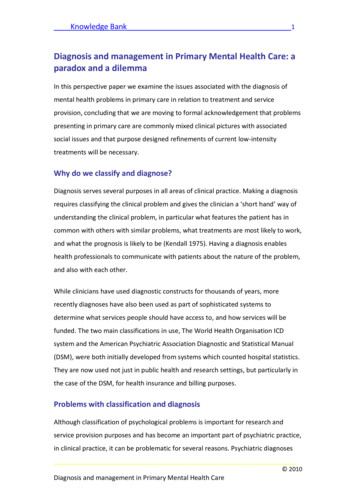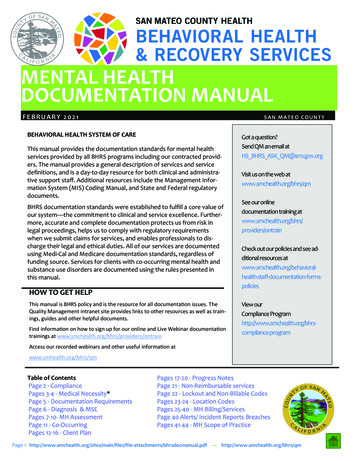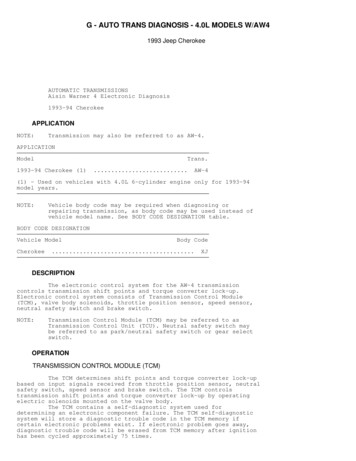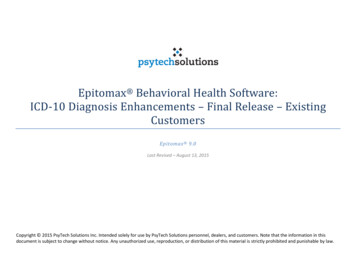
Transcription
Knowledge Bank 1Diagnosis and management in Primary Mental Health Care: aparadox and a dilemmaIn this perspective paper we examine the issues associated with the diagnosis ofmental health problems in primary care in relation to treatment and serviceprovision, concluding that we are moving to formal acknowledgement that problemspresenting in primary care are commonly mixed clinical pictures with associatedsocial issues and that purpose designed refinements of current low-intensitytreatments will be necessary.Why do we classify and diagnose?Diagnosis serves several purposes in all areas of clinical practice. Making a diagnosisrequires classifying the clinical problem and gives the clinician a ‘short hand’ way ofunderstanding the clinical problem, in particular what features the patient has incommon with others with similar problems, what treatments are most likely to work,and what the prognosis is likely to be (Kendall 1975). Having a diagnosis enableshealth professionals to communicate with patients about the nature of the problem,and also with each other.While clinicians have used diagnostic constructs for thousands of years, morerecently diagnoses have also been used as part of sophisticated systems todetermine what services people should have access to, and how services will befunded. The two main classifications in use, The World Health Organisation ICDsystem and the American Psychiatric Association Diagnostic and Statistical Manual(DSM), were both initially developed from systems which counted hospital statistics.They are now used not just in public health and research settings, but particularly inthe case of the DSM, for health insurance and billing purposes.Problems with classification and diagnosisAlthough classification of psychological problems is important for research andservice provision purposes and has become an important part of psychiatric practice,in clinical practice, it can be problematic for several reasons. Psychiatric diagnoses 2010Diagnosis and management in Primary Mental Health Care
Knowledge Bank 2may be unstable over time within an individual (Baca-Garcia E et al 2007; Ghazanshahi et al 2009). The psychiatric diagnostic categories themselves are also unstable– for example, in the change from the DSM III (265 disorders in 1980) to DSM IV (279disorders in 1994), 14 new disorders were introduced, with some new disordersbeing constructed and others disappearing. In ordinary psychiatric practice many ofthe treatments are not specific to existing diagnostic categories. Finally, having apsychiatric diagnosis is associated with the experience of stigma and discrimination,with some disorders being stigmatised more than others.In the primary care setting, diagnosis is associated with these problems butadditional issues add to the complexity. The diagnostic systems in common usage(i.e. the ICD and DSM systems) are largely derived from specialist psychiatricpractice, and reflect the kinds of sign and symptom patterns that are seen in thatsetting. Over the years the diagnostic categories have been refined to better reflectthe presenting problems and what is increasingly known about their aetiology andunderlying pathophysiology. In this process the number of diagnostic categories hasincreased and the inclusion and exclusion criteria have become more precise. Thisprocess has also led to increasing use of the ‘not otherwise specified’ categories aseven psychiatrists find the categories cannot accommodate the problems peoplepresent with. It led the classification system further away from what is commonlyseen in primary care: for example until its current version the DSM system did nothave a category for ‘mixed anxiety and depression’, the most common presentationin general practice settings. Furthermore, there has to date been a focus oncategories rather than considering symptoms and functioning in various domains asdimensions of experience and observable phenomena. In relation to treatment,there have been increasing attempts to tailor treatments to the more specificdiagnostic categories, although observation suggests that this is usually short-livedand that after a period the indications for new treatments tend to broaden out toinclude more diagnoses (i.e. the treatment becomes less specific).Alongside all these issues, a fundamental problem for primary care practitioners isthat the syndromes that reflect some aspects of problems presenting in psychiatric 2010Diagnosis and management in Primary Mental Health Care
Knowledge Bank 3practice quite well, do not suit primary care practice. This is because primary carepatients usually do not present with such clear cut patterns of signs and symptoms.People often present to primary care with mixed clinical pictures, and syndromesevolve over time. Furthermore, in primary care settings, people commonly presentwith non-specific psychological distress, i.e. with syndromes that do not meet thediagnostic threshold. Just over one quarter of primary care patients are consideredby GPs to have diagnostic sub-threshold problems. These ‘sub-threshold’ problemsare common, and are associated with significant suffering and impaired functioning(Collings et al. 2006; Martin et al. 1996; Wagner 2000). For example, many patientsin primary care with problem drinking would not reach the threshold for alcoholdependence, but nevertheless create significant problems for themselves, theirfamilies and society.Medically unexplained symptoms (i.e. a combination of psychological and persistentphysical problems with no detectable underlying pathology) often representpsychosocial distress and are common presentations in primary care. Many of thesesymptoms may come to be diagnosed as part of recognised medical conditions suchas irritable bowel syndrome, but when the symptoms persist or become multiple intheir nature it may be helpful to label them as a psychological problem. These can bechallenging to manage as it is not clear which aspect to prioritise, and practitionersare fearful of ‘missing’ a treatable medical condition while also often experiencingfrustration in the clinical relationship (Woivalin 2004).Presentations of non-specific psychological distress associated with psychosocialcomplexity (e.g. welfare, housing or family/whanau issues such as violence) arecommon and do not lend themselves to simple diagnostic frameworks or responses(Dowell, Garrett, Collings et al. 2009).These issues mean that both the diagnosis and treatment options for patientspresenting in primary care are less clear-cut than in secondary care. From aclassification perspective primary care does not fit well with the existing diagnosticsystems. From a prognosis perspective, there is less evidence about the course of 2010Diagnosis and management in Primary Mental Health Care
Knowledge Bank 4these mild-moderate mixed picture syndromes, but it we do know that a highproportion are eventually self-limiting (Jackson 2007).Mental health problem identification in primary careMost management of mental health problems takes place in primary care settings(Hornblow et al. 1990). Despite the problems with the utility of psychiatric diagnosis,primary care practitioners manage mental health problems frequently as part oftheir day-to-day work: over one third of adults attending primary care are likely tohave met the criteria for a DSM disorder over the previous 12 months (MaGPIeResearch Group 2003). How are the complexities outlined above resolved inpractice?We suggest that GPs are more interested in detecting psychosocial problems thandiagnosing them. Although it has been suggested that GPs fail to diagnose mentalhealth problems, we suggest that this claim is an oversimplification. GPs are effectiveat detecting mental health problems. The MaGPIe study showed that GPs identifiedpsychological issues in the past 12 months in 70% of people who had alreadypresented within the 12 month period and who had a diagnosable mental disorderduring that time, but in only 33% of those who had not been seen in the previous 12months. That study also showed that higher frequency of consultation wasassociated with problem detection (MaGPIe Research Group, 2005; Bushnell andMaGPIe Research Group, 2004). This suggests that continuity of care is an importantelement of problem detection. The same study showed that GPs considerfunctioning as well as symptoms when detecting psychological problems (Collingsand MaGPIe Research Group 2003), suggesting that GPs do not use the samediagnostic frameworks as used in secondary care.The clinical practice context is an important determinant of whether a primary carepractitioner will decide that a psychological problem is present, and whether adecision to actively manage it is appropriate at any given time. For example, havingdetected a psychological problem, the practitioner may choose to address othermore pressing problems in that consultation if the patient has minimal functional 2010Diagnosis and management in Primary Mental Health Care
Knowledge Bank 5impairment (Klinkman et al. 1997). Furthermore there are almost always otherconstraints such as time and resource issues (Klinkman 1997).Links between problem identification, diagnosis, clinical managementand service provisionBecause health resources (both money and skilled staff) are finite, there is a need tosystematically determine what problems ‘qualify’ for treatment and what treatmentoptions will be made available. The use of clinical diagnoses to determine access totreatment and other services is widespread in health services internationally, andranges from tightly prescribed options such as those common in Managed Caresettings in the USA, to clinician determined options which are common in secondaryand tertiary mental health services in New Zealand.Funding and service delivery in New Zealand primary mental health care (PMHC) iscurrently predicated on being able to define clinical problems using the generaldiagnostic fields offered in the DSM and ICD systems, and on being able todistinguish ‘mild-moderate’ from ‘severe’ problems. However, even outside mentalhealth, GPs are known to use widely varying practices in relation to diagnostic coding(Brown et al. 2003). Add to this what is known about the specific frailties ofpsychiatric diagnosis, and the uncritical use of a purely diagnostic approach in dayto-day primary care clinical practice must be open to question.Although the DSM and ICD diagnostic systems themselves are probably rarely usedin PMHC in New Zealand (Dew et al. 2005), the screening instruments that havecome into common usage as part of the process of determining eligibility for primarymental health services (e.g. the PHQ-9 and the K-10) are strongly linked to thesediagnostic frameworks (Kessler et al. 2003; Kroenkek 2002). The choice to use theseinstruments was a consequence of the thinking that simple and brief tools wereneeded to determine eligibility for treatement.We contend that this was easy to adopt in the PMHC setting because PMHCdevelopment in New Zealand was already being driven in part by secondary mentalhealth service thinking and philosophies. Two simple examples support this 2010Diagnosis and management in Primary Mental Health Care
Knowledge Bank 6assertion. The first relates to the default and even articulated age limits on most ofthe PMHC programmes running in New Zealand at present. Very few cater forchildren or people over the usual working age, replicating the age-based servicedivisions seen in secondary mental health services but not primary care. The secondexample is that most PMHC services essentially replicate the secondary care model,where people with certain kinds of problem, in this case mental health problems, arereferred out of the practice to be treated or managed by a person with ‘specialist’skills such as a counsellor or psychologist. Associated with this are potential barriersto treatment and good clinical management, including waiting times, possibly havingreferrals declined, having to locate and attend an unfamiliar treatment setting, poorcommunication between treating and referring clinician and administrative problems(Mathieson, Collings & Dowell 2009).We know that in New Zealand GPs take a very pragmatic approach to problemclassification and management (Dowell, Garrett, Collings et al. 2009). Diagnosis is notalways (or maybe even often) seen as a necessary step in arriving at a clinicalmanagement plan. Many GPs have been reluctant to ‘pigeon hole’ their patientswith psychiatric labels, particularly if there are, for example, insurance companyimplications (Dew et al. 2005). Primary care practitioners will more often use genericlabels such as anxiety/depression. They tend to be ‘lumpers’ when it comes toclassification rather than ‘splitters’ who create multiple sub-categories. Practitionersare aware of the impact of psychosocial issues and are prepared to classifyaccordingly. In some parts of the country service provision is dependent on apsychiatric or DSM diagnosis, and where this is the case then GPs will tailor adiagnostic category to ensure access to treatment. In other cases, the practitioneronly has to provide a ‘diagnosis’ of ‘mild/ moderate mental health problem, toobtain services for a patient.The apparent paradox of PMHC is that while most mental health care is provided inprimary care settings and this is usually done without a formal psychiatric diagnosis,treatment can be very effective at reducing symptoms and improving functioning(Dowell, Garrett, Collings et al. 2009). This brings with it a significant dilemma for 2010Diagnosis and management in Primary Mental Health Care
Knowledge Bank 7those working in policy, planning and funding, for whom the accurate estimation andforecasting of clinical activity and associated budgets is critical. While funders mayrecognize the reality of primary care practice, they find it hard to commit funding toprogrammes that appear loose in their prescription.Figure 1 on the next page illustrates the elements of the primary care practitioner’sprocess for detecting and characterising mental health problems. This is adaptedfrom our previously published work (Dew et al. 2005) to highlight the introduction ofscreening for the determination of eligibility to receive services. During the course ofa consultation, the clinician weighs up the options around focussing on one problem,or one aspect of a problem, over others. Note that the determination of eligibility toreceive primary mental health services outside the routine consultation can occur atany time and is not contingent on a formal diagnosis being made. In some cases thepractitioner will have decided early on that additional help for the psychological orpsychosocial issue is warranted and will construct the diagnostic or other eligibilitycriteria to ensure the person receives help. 2010Diagnosis and management in Primary Mental Health Care
Knowledge Bank 8Problem detectionMindful em characterisation(may include formal diagnosis)Mindful prioritisingProblem managementWatchful waitingAdviceCounsellingSelf-helpSpecific treatmentReferral onFigure 1: The primary mental health assessment process, which is reiterated overmultiple consultations: mindful prioritising between multiple competing issues 2010Diagnosis and management in Primary Mental Health Care
Knowledge Bank 9An interesting aspect of PMHC development in New Zealand is that there is an upperthreshold for eligibility. The original Primary Mental Health Initiatives were requiredto be designed so that those with ‘severe’ disorders were not seen but were referredon to secondary care. This created some interesting scenarios where it was knownby GPs that the local secondary services would not accept the referral. as althoughscreening scores (e.g. K10 scores) were at the severe end, the person was neitherpsychotic nor at risk of suicide. These people were commonly kept in the PMHCservice and often managed effectively.The dilemma around treatment provision in primary care is compounded byinconsistent links between the type of clinical problem and treatment. In primarycare there appears to be a lack of a tight linkage between problem type (ordiagnosis) and clinical management. At the high level of the Primary Mental HealthInitiatives Evaluation, it appeared that brief non-specific treatment approaches madea clinically important difference for most people (Dowell et al. 2009). Even at a morespecific level, treatments for mild-moderate depression are effective for patientswith mild-moderate anxiety. There was no real difference in the proportional benefitbetween patients with anxiety or depression and those in whom social factors wereprominent in their assessment. Regardless of the combination of problem andtreatment, up to 80% of patients showed some overall improvement and 58.1%showed an improvement of at least 20 percentage points on their outcome followingintervention (equivalent to a change of 8 points on the K10).However, for problems which are mainly characterised by depressive symptoms ofmild to moderate severity, both drug and psychological therapies are effective (NICE2004; De Rubeis et al. 2005; de Mello et al. 2005). This makes the dilemma moreacute for service planners and funders, as while psychological therapies may bebetter tolerated (NICE 2005) and may have a more sustained effect (Ma & Teasdale2003; Teasdale et al. 2000), they may be less accessible due to cost and skillavailability. The patient with moderate depression could be treated for six sessionsof CBT or given a prescription for an SSRI with very similar treatment outcomes, and 2010Diagnosis and management in Primary Mental Health Care
Knowledge Bank 10significant difference in health care costs. This scenario needs to be tempered withthe knowledge that there is some suggestive evidence that for mild-moderatedisorders, talking therapies may be better than medication and that medication isdefinitely more effective with more severe than with moderate disorders.Towards a resolutionThe fundamental purposes of diagnosis are to ensure the patient has the mostappropriate effective treatment and can be given an account of how they can expectto be in the future, so they can actively participate in the management andprevention of future episodes where possible. It is therefore important that primarycare practitioners portray an accurate picture of the way they themselves areframing the problem. For example, it is quite appropriate not to give, say, a simplediagnosis of depression, but tell a patient that a particular presentation is a commonkind of psychological problem where depression and anxiety are mixed.Both assessment and management should be pragmatically geared to the workingenvironment of PMHC and the kinds of problems that present. At the internationallevel the ICD and DSM classifications are currently being revised, and both willaddress general practice and primary care working practices. The outcome is likely tobe a smaller number of broader groupings that cover the main problems seen inprimary care.For planners and funders at DHB and PHO level, funding and management needslikewise to be geared to broader groupings and not tied to specific diagnosticcategories. Funding and services need to be inclusive of the wide range of problemsseen in primary care and to fund the social components of management options.Because of the large numbers of potential patients services need to be tailored torelative efficiency. This means that we may see a reduced range of specialisedpsychological therapies being offered within the PMHC frame, accompanied by thedevelopment of more available generic low intensity interventions specificallydesigned to be delivered in primary care for problems as they present in primary 2010Diagnosis and management in Primary Mental Health Care
Knowledge Bank 11care (Collings, Mathieson, Dowell et al. 2009). Such interventions will fit in betweenself-help and more specialised therapies in the treatment menu, and are likely tobecome one of the standard treatment options in New Zealand PMHC.ReferencesBaca-Garcia E, Perez-Rodriguez M, Basurte-Villamor I, Fernandez Del Moral A,Jimenez-Arriero M, Gonzalez De Rivera J, Saiz-Ruiz J, Oquendo M. 2007. Diagnosticstability of psychiatric disorders in clinical practice. British Journal of Psychiatry190:210-216.Brown P, Warmington V, Laurence M, Prevost A. 2003. Randomised crossover trailcomparing the performance of Clinical Terms Version 3 and Read Code codingschemes in general practice. British Medical Journal 326:1127-1132.Brown P, Warmington V, Laurence M, Prevost A. 2003. A methodology for thefunctional comparison of coding schemes in primary care. Informatics in primarycare 11:145-148.Bushnell J & MaGPIe Research Group. 2004. Frequency of consultations and generalpractitioner recognition of psychological symptoms. British Journal of GeneralPractice 54(508) 838-842.Collings S & MaGPIe Research Group. 2006. Disability and the detection of mentaldisorder in primary care. Social Psychiatry and Psychiatric Epidemiology, 40:9941002.Collings S, Mathieson F, Dowell A, Goodyear-Smith F, Hatcher S, Stanley J. 2009.Ultra-brief intervention treatment manual: GP version. University of OtagoWellington.De Mello M, de Jesus Mari J, Bacaltchuk J et al. 2005. A systematic review of researchfindings on the efficacy of interpersonal therapy for depressive disorders. EuropeanArchives of Psychiatry and Clinical Neuroscience 255(2)75-82.De Rubeis R, Hollon S, Amsterdam J et al. 2005. Cognitive therapy vs medications inthe treatment of moderate to severe depression. Archives of General Psychiatry62(4) 409-416.Dew K, Dowell A, McLeod D, Collings S & Bushnell J. 2005. ‘This glorious twilight zoneof uncertainty’: mental health consultations in general practice in New Zealand.Social Science & Medicine 61(6) 1189-1200. 2010Diagnosis and management in Primary Mental Health Care
Knowledge Bank 12Dowell A, Garrett S, Collings S, McBain L, McKinlay E, Stanley J. 2009. Evaluation ofthe Primary Mental Health Initiatives: Summary Report. Wellington. University ofOtago Wellington and Ministry of Health.Ghazan-shahi S, Roberts N, Parker K. 2009. Stability/Change of DSM Diagnosesamong children and adolescents assesses at a University Hospital: A cross-sectionalcohort study. Journal of the Canadian Academy of child and adolescent psychiatry18(4):287-292.Hornblow A, Bushnell J, Wells J. 1990. Christchurch Psychiatric Epidemiology Study:use of mental health services. New Zealand Medical Journal 103(897):415-417Jackson J, Passamonti M, Kroenke K. 2007. Outcome and impact of mental disorderin primary care at five years. Psychosomatic Medicine 69:272-276.Kendall, R. 1975. The role of diagnosis in psychiatry. Blackwell Scientific Publications.Oxford.Kessler R, Barker P, Colpe L, Epstein J, Gfroerer J, Hiripi E, Howes M, Normand S,Manderscheid R, Walters E & Zaslavsky 2003 Screening for serious mental illness inthe general population. Archives of General Psychiatry, 60: 184-189KIinkman M, Schwenck T & Coyne J. 1997. Depression in primary care-more likeasthma than appendicitis: the Michigan Depression Project. Canadian Journal ofPsychiatry 42(9) 966-973.Klinkman M. 1997. Competing demands in psychosocial care: A model for theidentification and treatment of depressive disorders in primary care. GeneralHospital Psychiatry 19:98-111.Kroenkek K, Spitzer R. 2002. The PHQ-9: a new depression and diagnostic severitymeasure. Psychiatric Annals 32:509-521Ma S & Teasdale J. Mindfulness-based cognitive therapy for depression: replicationand exploration of differential relapse prevention effects. Journal of Consulting andClinical Psychology, 72(1).MaGPIe Research Group. 2003. The nature and prevalence of psychological problemsin New Zealand primary healthcare: a report on Mental Health and General PracticeInvestigation (MaGPIe). New Zealand Medical Journal 116(1171):1-15.MaGPIe Research Group. 2005. The effectiveness of case-finding for mental healthproblems in primary care. British Journal of General Practice 55: 665–669.Martin J, Blum T, Beach S, Roman P. 1996. Subclinical depression and performance atwork. Social Psychiatry 31(1):3-9 2010Diagnosis and management in Primary Mental Health Care
Knowledge Bank 13Mathieson F, Collings S, Dowell A. 2009. Sub-threshold mental health syndromes:finding an alternative to the medication of unhappiness. Journal of Primary HealthCare 1(1).NICE (National Institute for Health and Clinical Excellence) 2005. Depression:management of depression in primary and secondary care. National Clinical PracticeGuideline Number 23. London. National Institute for Health and Clinical Excellence.Teasdale J, Segal Z, Willimas J et al. 2000. Prevention of relapse/recurrence in majordepression by mindfulness-based cognitive therapy. Journal of Consulting andClinical Psychology 68(4)615-623.Wagner H, Burns B, Broadhead W, Yarnall K, Sigmon A, Gaynes B. 2000. Minordepression in family practice: functional morbidity, co-morbidity, service utilizationand outcomes. Psychological Medicine 30:1377-1390Woivalin T, Krantz G, Mantyranta T. 2004. Medically unexplained symptoms:perceptions of physicians in primary health care. Family Practice 21(2):199-203. 2010Diagnosis and management in Primary Mental Health Care
Diagnosis serves several purposes in all areas of clinical practice. Making a diagnosis requires classifying the clinical problem and gives the clinician a short hand way of understanding the clinical problem, in particular what features the patient has in common with others with similar problems, what treatments are most likely to work,










